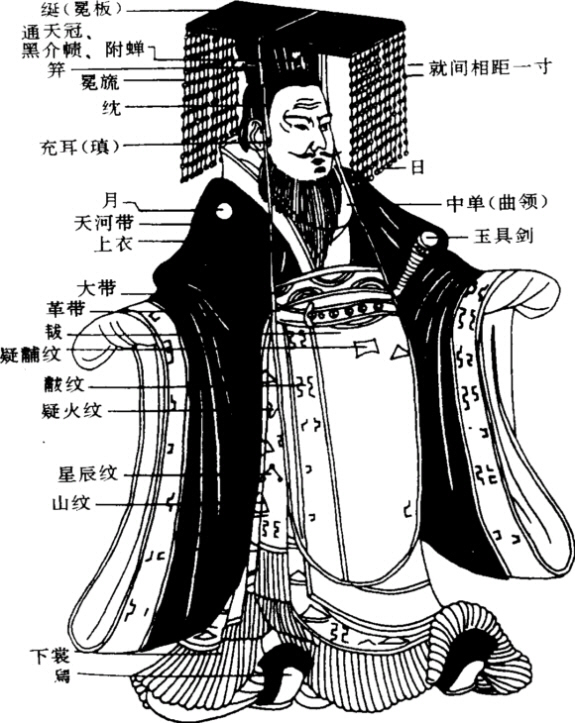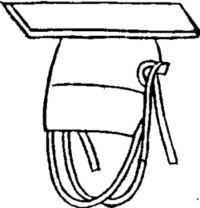Chapter 4 The second week dress
The Xia and Shang Dynasties belonged to the initial period of China's crown clothing system, and a complete system has not yet been formed.In the Zhou Dynasty (from the 11th century BC to 256 BC), Chinese society transitioned from slavery to feudalism. With the establishment of the feudal system, China's crown and clothing system was gradually improved, and it became the ruler's "famous distinction, distinction Waiting for power" tool.In order to take charge of the implementation of the crown service system, the ruler specially set up the official position of "sifu".For this system, people can only strictly abide by it. If anyone "touches the emperor's order and revolutionizes the public opinion system", he will be severely punished by "劓 [yi Yi] punishment" (cutting off the nose) ("Zhou Li· Si Xing" Zheng Zhu cited "Shang Shu Da Biography").
According to the rules and regulations of the Zhou Dynasty, when the sacrificial ceremonies (including offering sacrifices to heaven and earth, the five emperors, offering sacrifices to the ancestors and ancestors, offering sacrifices to archery, offering sacrifices to the surrounding mountains and rivers, offering sacrifices to the country, etc.), as well as court meetings and wedding receptions, the emperor and hundreds of Officers must wear formal attire.The dress is composed of Mianguan, Xuanyi and 〔xunxun, a kind of red〕clothes, which are collectively called Mianfu.
The crown is the most noble crown worn by emperors and officials when they participate in sacrificial ceremonies.The idiom "crown-sounding" is derived from the sense that the crown is very dignified and dignified.Mianguan, including Mian綖〔yanyan〕, Chui旒〔liu Liu〕, Chonger and other parts.Mian 綖, also known as "mian board", is on the top of the crown, usually made of wood, mounted with fine cloth, painted black on the top and red on the bottom, with a round front and a rear (a metaphor for heaven and earth), low at the front and high at the back, in the shape of It is inclined to show prostration and humility; the front and back of the crown are hung with slacks, named slung slacks, which are made of colorful silk strips, and colorful round beads are worn on them, and a string of pearls and jade is a slack.There are 12 crowns on the front and back of the emperor's crown, and 288 jade pieces are used to express the meaning that the king does not regard wrongs and evils.The phrase "turning a blind eye" in later generations was derived from this.Below the crown is the crown, which was called crown volume in ancient times.It is named because it is woven into circles with iron wire, lacquered yarn, and fine rattan.There is a hole on each side of the crown, which is used to intersperse the jade rod and tie it with the braid.On the other end of the hairpin, tie a ribbon (named crown tassel), go around under the chin [hanhan], and tie it to the other end of the hairpin to fix the crown.There is also a pearl hanging from each ear, named "黈纩 [toukuang stealing the mine]", also known as "Chonger" or "瑱 [tiantian]".It is said that this has the meaning of reminding the emperor not to hear anything and not to listen to slander.When the emperor was walking, the pearls would shake constantly and lightly tap the ear of the emperor to warn him to turn a deaf ear to slander.The crown is divided into six styles: Daqiu (Lambfur) crown, Gun (gun roll) crown, Bi (bi cover) crown, Wu (cui crisp) crown, Xi crown and Xuan crown, collectively called "six crowns" or "Six clothes".They have different names, functions and shapes.Daqiu Mian is the dress worn by emperors to offer sacrifices to heaven; Dagon Mian is the dress worn by emperors to offer sacrifices to their ancestors; Yu Mian is the dress worn by emperors and nobles to sacrifice their ancestors and perform sacrifices and shooting ceremonies; Mian, also known as "絺mian", is a dress used to sacrifice to the country; Xuanmian is specially used for small sacrificial activities.
According to etiquette regulations, those who wear a crown must wear a crown.The texture, color and pattern of the crown suit are different, and there are differences in grades.For example, the Xuanyi of the emperor's mianfu is a top made of black material, and the skirt is a lower skirt made of light red material.The upper garment is painted with six patterns of sun, moon, stars, mountains, dragons, and Chinese insects; the lower garment is embroidered with six patterns of Zongyi, Zao, Fire, Fenmi, Fu, and Fu (Fu Fu), collectively known as twelve patterns. Chapter pattern.They each represent a certain meaning.The sun, the moon, and the stars mean that the Son of Heaven shines on the world, shining like the sun, the moon, and the stars; the mountain symbolizes the king's stability and stability; There is the virtue of articles; Zongyi (a ritual vessel) means that the master is mighty and wise; algae (water plants) means cleanliness, which symbolizes the king's pure character; fire means that the king leads the people to submit to the destiny; powder Rice (white rice) symbolizes the virtue of the ruler to help and support all living beings; Fu, the painting is in the shape of an axe, which means that the king is good at making decisions; Fu, the painting
The emperor wore a crown with twelve chapters on the most solemn occasions, and on other occasions, the number of chapters was reduced according to the importance, roughly corresponding to the number of crowns.For example, if nine pins are used for the crown, seven chapters should be used for the crown; if seven pins are used for the crown, five chapters should be used for the crown, and so on.In addition, on the most solemn occasions, the emperor still had to wear Chi Xi (xi gap) 絇 (qu canal) shoes (a kind of red shoes made of silk and satin, with a moisture-proof wooden sole and laces).On other occasions, white or black Xie should be worn.The feudal lords and dignitaries accompanied the emperor to participate in the sacrificial ceremony, and the number of seals used on the mianfu should be reduced according to the number of seals used by the emperor.For example, the emperor uses twelve chapters, the public servant can only use nine chapters, the uncle can only use seven chapters, and so on.
There are also some accessories in the mianfu: one is "Fu [fu Fu]", which covers the knees, is tied on the leather belt and hangs down to the knees, symbolizing the ancient fig leaf to express the meaning of not forgetting the past; the second is the "leather belt" , made of leather, used to tie the belt and ribbon; the third is the "big belt" (also known as the ribbon), made of silk, used to tie the waist, and the drooping part is called "gentry".Later generations called people with status "gentlemen" because of this.In addition, there are "pei shou" and Xie and so on.Mianfu has been passed down from generation to generation. Although it has been constantly changing, the general shape has not changed, and it has always been regarded as a traditional legal uniform.It was not until the Qing Dynasty entered the Central Plains that the mianfu system was abolished.

Diagram of crown suit
In addition to Mianfu, there was also a dress called Bianfu in the Zhou Dynasty.It is second only to the mianfu and is the earliest court clothing.It is said that it is called because it is worn on the head as a bean.Bian has various shapes such as Jue Bian, Pi Bian, Wei Bian, and Guan Bian.Juebian, also known as "queenbian", is a kind of first service second only to Mian.It is the highest clothing for scholars, and its shape is like a crown, but the crown has no tendency to tilt, and there is no sway at the front and back. It is made into two palms at the bottom of the box. The color is not black at the top and red at the bottom, but the color of "bird head". (a color with more red and less black).Those who wear Juebian must wear pure clothes (silk clothes, that is, black clothes) on the top, and clothes on the bottom, but without Zhangcaiwen decorations. In front of them, they use 韎韐 [mei ge sister partition, knee covering on sacrificial clothes] instead of mian clothes Fu.Pibian is worn by the emperor when he accepts the pilgrimage of the princes [JIN Jin] or when the princes are in court and hunting in the fields.Shaped like an overturned cup, it is sewn from white buckskin.At the seam, there is a row of shining jade stones, shining like stars.Therefore, "The Book of Songs·Wei Feng·Qi Ao [YU Yu]" has a verse of "Hui Bian is like a star".Those who wear leather bows should wear fine cloth white clothes on top, plain clothes on the bottom, with pleats in the waist [Jian Jian], and Wei Wei on the front.Wei Bian, made of Wei Wei (red cooked leather dyed with thatch grass).Mainly used in military occasions.When performing military tasks, it is necessary to wear red hats, red clothes and red clothes.On other occasions, cloth is used as clothes and plain clothes are worn.Crown Bian, commonly known as leather crown.It is worn for field hunting and military training.Those who wear crowns must wear black (zizi, black) cloth clothes on top, and plain clothes (pleated lower clothes made of white non-grained silk fabric) on the bottom.According to "Zuo Zhuan Twenty Years of Zhaogong": Once the Marquis of Qi was hunting in Peize, he sent an order to summon Yuren (the official in charge of Shanze).The people of Yu didn't answer the call at first, but they came in after seeing the Marquis of Qi wearing a crown.It can be seen that it is against the ancient etiquette not to use the crown.Although humble as the Yu people, they should treat each other with courtesy and not be insulted.

Jue Ben
In the Zhou Dynasty, there was also a court dress called Xuanduan.It can be worn from the emperor to the scholar.It is mostly made of black cloth, the sleeves are the same size as the length of the garment, without any pattern or decoration, and the shape is dignified and square, hence the name Xuanduan.The first server that matches Xuanduan is Wei Maang Guan.The weimang crown is similar in shape to the Pi Bian, and is made of black silk [Zeng Zeng].
Queen's clothing also has a certain system.There are six kinds of garments: Yi [huihui] garments, Ruizhai [yudi Yudi, Yizuidi], Quedi, Juyi, Zhanyi, and Tuantuanqu (see "Zhou Li·Tianguan·Neisi "clothes"), all belong to even clothes.The reason why these six styles of clothes are not divided into upper and lower is said to be intended to express women's advocacy and single-mindedness.The first three are the dresses that the queen wears when accompanying the emperor to participate in various sacrificial ceremonies, all of which are decorated with Zhai (long-tailed pheasant) patterns, but the colors are black, blue and red.Juyi is the yellow-green (like the color of a newborn mulberry leaf) dress that the queen wears to offer sacrifices to the late emperor when the silkworm breeding season comes.Zhanyi, also known as Tan (tan) clothing, is a white dress worn by queens when they meet emperors and guests at banquets.The kimono is the black casual clothes worn on weekdays.When wearing these clothes, in order to show their respective colors, they are also lined with plain yarn (white gauze [huhu]).In addition, on the most solemn occasions, the queen has to wear the "vice" (like the false bun buyao in the Han Dynasty) as the head dress, with black shoes on her feet.As for the costumes of other noble ladies, there are also specific systems, which strictly reflect the differences in rank.

Diagram of crown suit

Jue Ben
